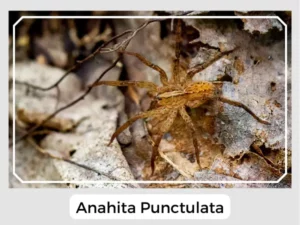Have you ever heard of Southeastern wandering spiders? They’re part of the big Ctenidae family and come from the Anahita group. These spiders can be found in various places in America.
The eggs are small and round enclosed safely inside a silken sac.
Though sufficient details remain unavailable, they stay with their kin until maturation and then disperse to be on their own.
Like other wandering spiders, this species too does not spin webs but attacks their prey by suddenly attacking them from their hidden den.
Yes, Southeastern wandering spiders do have venom. It helps them catch and eat their food. But for most people, it’s not super dangerous.
Sure can! Like many spiders, they might bite if they get scared. It can be a bit painful, but usually, it’s okay. Best to be gentle with them!

Photo Credit: Kathy Hardy
Southeastern wandering spiders play an essential role in maintaining the balance of their ecosystems. By preying on small insects, they help control the population of potential pests, contributing to a healthier environment. Their nomadic nature and ambush-hunting tactics showcase their adaptability and resilience, making them fascinating subjects for arachnological studies.
Natural Predators and Prey-Predator Dynamics: In the wild, these spiders face threats from birds, larger spiders, and other predators. The sophisticated dance between predator and prey is a vital aspect of their existence, influencing their behavior, life cycle, and the broader ecological balance.
Relationship with Humans: While encounters with humans are infrequent, it’s crucial to foster a respectful and informed relationship with these spiders. Understanding their role in the ecosystem and acknowledging their generally non-threatening nature helps in demystifying these creatures, paving the way for coexistence and appreciation.
| Distribution | Kentucky, Georgia, Tennessee, and Alabama |
| Habitat | Burrows, ground, plants, or even fruits like bananas |
| Diet | Small insects |
| Lifespan | About 1 year |
In summary, the Southeastern wandering spiders are a remarkable testament to the adaptability and resilience of arachnids.
Have you ever heard of Southeastern wandering spiders? They’re part of the big Ctenidae family and come from the Anahita group. These spiders can be found in various places in America.
The eggs are small and round enclosed safely inside a silken sac.
Though sufficient details remain unavailable, they stay with their kin until maturation and then disperse to be on their own.
Like other wandering spiders, this species too does not spin webs but attacks their prey by suddenly attacking them from their hidden den.
Yes, Southeastern wandering spiders do have venom. It helps them catch and eat their food. But for most people, it’s not super dangerous.
Sure can! Like many spiders, they might bite if they get scared. It can be a bit painful, but usually, it’s okay. Best to be gentle with them!

Photo Credit: Kathy Hardy
Southeastern wandering spiders play an essential role in maintaining the balance of their ecosystems. By preying on small insects, they help control the population of potential pests, contributing to a healthier environment. Their nomadic nature and ambush-hunting tactics showcase their adaptability and resilience, making them fascinating subjects for arachnological studies.
Natural Predators and Prey-Predator Dynamics: In the wild, these spiders face threats from birds, larger spiders, and other predators. The sophisticated dance between predator and prey is a vital aspect of their existence, influencing their behavior, life cycle, and the broader ecological balance.
Relationship with Humans: While encounters with humans are infrequent, it’s crucial to foster a respectful and informed relationship with these spiders. Understanding their role in the ecosystem and acknowledging their generally non-threatening nature helps in demystifying these creatures, paving the way for coexistence and appreciation.
| Distribution | Kentucky, Georgia, Tennessee, and Alabama |
| Habitat | Burrows, ground, plants, or even fruits like bananas |
| Diet | Small insects |
| Lifespan | About 1 year |
In summary, the Southeastern wandering spiders are a remarkable testament to the adaptability and resilience of arachnids.